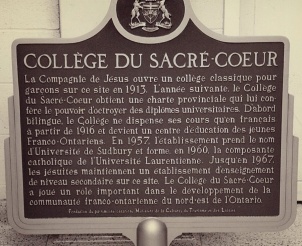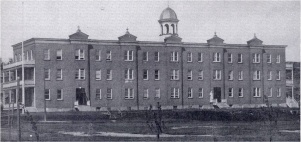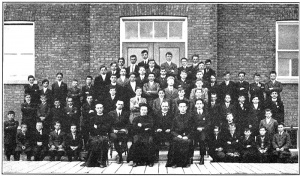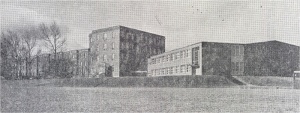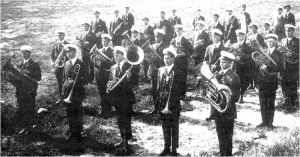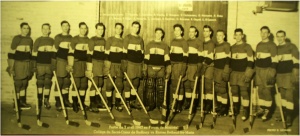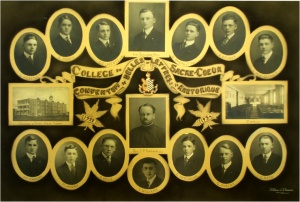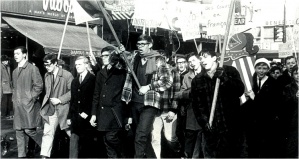Sacred Heart College, Sudbury
par Riopel, Pierre
An Ontario Heritage Trust plaque at the corner of Notre-Dame and Kathleen streets in Sudbury marks the location of Sacred Heart College. Thousands of students passed through the college doors over the years, with many going on to become leaders who left their mark on the Franco-Ontarian community and beyond. The English plaque reads as follows: “The Society of Jesus opened a classical college at this site in 1913. The next year the province granted Sacred Heart College a charter giving it degree-granting powers. At first the college was bilingual, but after 1916 it taught exclusively in French. Sacred Heart College became a centre for the education and formation of young Franco-Ontarian men. In 1957, it changed its name to the University of Sudbury, which became the Catholic component of Laurentian University in 1960.” Sacred Heart College played a crucial role in the flowering of French Ontario’s collective identity and memory. It was here that Société historique du Nouvel-Ontario (SHNO) was founded in 1942. Today, this important heritage organization keeps local history alive with its archival collection, conferences and publications.
Article disponible en français : Collège Sacré-Coeur de Sudbury
A College is Founded
The dream of founding a classical college had been in the air in Sudbury since the railroad opened up new agricultural lands and attracted an influx of French-Canadians (NOTE 1). In 1886 the Jesuit Hormidas Caron, priest of Sudbury’s first Catholic parish, Sainte-Anne, bought 300 acres of land from the Canadian Pacific Railway for this purpose. But the dream would wait until 1905 when Monsignor David Joseph Scollard, titular bishop of the diocese of Sault-Ste-Marie, authorized R.P. Édouard Lecompte, the superior of the Canadian Jesuit mission, to create a college. Petitions and requests for support were then submitted to various Church and government authorities.
The first rector (1913–15), Jesuit Father Gustave Jean, explained the choice of Sudbury for the school:
Sudbury, with its population of 6–7000 souls, at least half of whom are Catholic, and four-fifths of the same French Catholic, was chosen over Sault-Ste-Marie for its more central location. It is both the geographical centre of the diocese and the epicentre of the area’s largest Catholic population, making it a focal point for Catholic settlers, who are flocking to the adjacent countryside and founding parishes. Geographically speaking, this fast-growing centre is enviably situated. Several rail lines intersect there, spreading outward in all directions. The city is also a supply centre for the many surrounding mines. Businessmen feel that the city stands to grow considerably (NOTE 2).
On March 25, 1912 the Superior General of the Jesuits gave the go-ahead to build a classical college in Sudbury. Construction began on the site set aside by the Jesuit fathers at Notre-Dame and Kathleen in a neighbourhood known as the Flour Mill (Moulin à fleur in French), after the nearby silos and mill. Today, the area is well known as Sudbury’s main French-speaking neighbourhood, much like Saint-Boniface in Winnipeg and Vanier in Ottawa.
The cornerstone was consecrated on Sunday, August 25, in the presence of the Bishop of Sault-Ste-Marie, Monsignor Scollard, provincial Reverend Father of the Jesuits, Judge Kehoe and Monsignor Crowley, priest of Copper Cliff. The college charter was drafted a few months later.
The College Charter
On April 20, 1914, the Ontario legislature adopted the Charte du Collège du Sacré-Cœur (NOTE 3) setting out the rights and responsibilities of the college administrators. Provincial MLA Charles McCrea was influential in getting this law passed.
The administration of Sacred Heart College was entitled to
- establish and maintain faculties, university colleges, universities, observatories and other such institutions;
- undertake and develop the study of languages, history, philosophy and other fields of knowledge.
The college administration had the authority to
- establish and superintend, in the city of Sudbury and elsewhere in the province of Ontario, university colleges or faculties…where students could acquire a liberal education in the arts and sciences;
- organize study, work and research in these disciplines…so as to promote education be it general, vocational or technical;
- grant certificates and diplomas;
- in order to fulfil the objectives of ends of the said administration (NOTE 4).
This legislation led to the creation of the University of Sudbury in the late 1950s and was the topic of considerable debate regarding the establishment of a Franco-Ontarian university.
The Student Body
On September 3, 1913, Conrad Daigle from Warren, Ontario registered at Sacred Heart College: the first of thousands of students who would attend this Jesuit college in the century to come (NOTE 5). The school’s graduates would take leadership roles in the Franco-Ontarian community and beyond. Daigle, for example, became a priest in 1931 and served faithfully in the diocese of Sault-Sainte-Marie.
Seventy-two students registered in the college’s first year. As time went by, the number climbed into the hundreds, where it remained. For example, 203 students attended in 1939, 262 in 1942 and 327 in 1947. Most were boarders—240 out of 318 in 1953—while the rest were day students. They came mainly from mid-northern Ontario districts like Sudbury (Sudbury, Chelmsford, Noëlville, Chapleau) and Nipissing (Sturgeon Falls, North Bay). Some came from the districts of Cochrane, Temiskaming and Algoma, while others travelled from southern Ontario and as far as Quebec and Saskatchewan.
The first students to complete their classical education at Sacred Heart College graduated in 1922. Among them were Antonio Cantero, a future doctor who went on to become director of the Montreal Cancer Institute and a member of the Royal Society of Canada; Léon Lalande and Herman Fournier, who were called to the Bar; Gérard Fauteux, who became a Supreme Court Justice; and distinguished citizens Denis Janisse and Denis Maurice.
The Campus
The College was built in three main phases between 1913 and 1963.
The original building, known as the old section after 1963, had two superposed hallways and balconies at the north and south end. The first floor held a recreation room, the students’ chapel (including the sacristy and procuracy), dormitory, kitchen and dining hall as well as the Reverend Father’s office, bedroom and parlour. A study hall for students, a classroom, the Jesuit fathers’ quarters and dining hall and another recreation room were located on the second floor, with a private room for the college rector.
Between 1926 and 1927, an addition to the original building was built to accommodate the growing student body. On the first floor the north addition included a new recreation hall for students with space for theatre and band practices. The old recreation hall was subdivided into classrooms, a dormitory, a meeting room and a library shared by students and the Jesuit fathers. The student dining hall was also enlarged. The student chapel and a study hall were located on the second floor of the new section, while the second floor of the original building was renovated to add physics and chemistry labs. The Jesuits’ quarters remained essentially unchanged. The third and fourth floors of the new wing included dormitories.
Toward the end of the 1920s the Jesuits converted an existing pond on the college grounds into a swimming pool. Twenty years later, the sides and bottom of the pool were cemented over. Not long after, new playing fields provided the finishing touch to the grounds.
In 1951 a third and final phase of construction added a gym and additional classrooms.
Sports and Cultural Activities at the College
Education at Sacred Heart College went beyond the academics typical of classical colleges. In addition to religion, French, Latin, modern history, mathematics, science, Greek and English students were encouraged to take part in numerous extracurricular activities (NOTE 6).
From the beginning, the school band (NOTE 7) was a favourite of college students, while theatre troupes (NOTE 8) offered many young men a first chance to tread the boards. Between 1915 and 1961 nearly seventy plays were produced including works by Molière (Le malade imaginaire, 1927 and 1952; Le bourgeois gentilhomme, 1930 and 1951; Le médecin malgré lui, 1932 and 1953) and Cocteau (Oedipe Roy, 1951) as well as occasional pieces written by the Jesuit priests themselves. Visual art were another avenue of expression open to students, with the “Cercle Matisse.” In the school choir, Les compagnons du Sacré-Cœur, students learned to sing a repertoire of period favourites.
Sports were also an essential part of the young men’s education with hockey, basketball, and track teams (NOTE 9). The Jesuit fathers understood the value of “a healthy mind in a healthy body.”
Various speakers also visited the college over the years to share their wisdom with students. Among the many high profile visitors were Frère André in 1916, Senator Philippe Landry in 1917, Henri Bourassa in 1921, Governor-General Lord Byng in 1922, Dominion Archivist and Franco-Ontarian writer Séraphin Marion in 1929, violinist Arthur Leblanc in 1944 and 1946, Canon Lionel Groulx in 1944, Lester B. Pearson in 1951 and Monsignor Félix-Antoine Savard in 1952.
Over the course of the century the collégiens (as the students were known) took part in numerous extracurricular activities and good works. Among the clubs and associations were Cercle Philippe-Landry, the Saint-Vincent-de-Paul Society, the young naturalists club, Cercle Lacordaire, the Caisse populaire and Service missionnaire des jeunes. Budding journalists honed their skills writing for the various college newspapers, including Le Gaillard (founded in 1920), Le Lien (1938) and Promesses (1949) (NOTE 10).
Alumni
Many Sacred Heart graduates became leaders in their communities and professions. These lawyers, regular and secular priests, technicians, businessmen, doctors, teachers, professors, accountants, dentists and civil servants have greatly contributed to the development of the Franco-Ontarian community and Canada as a whole.
Sacred Heart graduates include Jean Éthier-Blais, an esteemed literary figure; Osias Godin, who served as the federal MP for Nickel Belt (1958–1965); Camille Lemieux, who founded a newspaper, L’ami du peuple; Monsignor Roger Despatie, Bishop of Hearst (1973–1993); Robert Vigneault, University of Ottawa professor emeritus in French Literature; Robert Paquette, a singer; Denis St-Jules, Radio-Canada radio host; and André Paiement, an actor, playwright, director, singer-songwriter and cofounder of Théâtre du Nouvel-Ontario and Coopérative des artistes du Nouvel-Ontario (CANO). Quebec environmentalist Pierre Dansereau also spent a year at the college. Since the first alumni reunion on June 17, 1928, many groups have gotten together over the years, renewing the fraternal bonds developed at the college.
Some noteworthy teachers also left their mark: the Jesuit Fathers Rodolph Dubé, a.k.a. François Hertel, political pamphleteer; Germain Lemieux, ethnologist and founder of the Centre franco-ontarien de folklore; and Gilles Garand, founder of the Laurentian University Theatre troupe.
A Legacy to Preserve
Sacred Heart College closed its doors in 1967—a period of self-examination for Franco-Ontarians—as the province of Ontario prepared to fund French-language secondary education (NOTE 11). The college is an important part of the cultural heritage of Sudbury and French-speaking Ontario, both as a physical institution that brought the Franco-Ontarian community together and through the far-reaching impact of its teaching in many spheres of endeavour. Alumnus Maurice Fredette ably sums up the educational mission of northern Ontario’s Jesuit Fathers:
The College’s role? Nowadays it’s pretty much the same as at the beginning: preserve the French language in an English environment. I see the college as an institution dedicated mainly to young men’s overall development rather than rote learning. The important thing isn’t memorizing facts and formulas, but learning how to make judgements and to understand. The college’s role is to educate men able to stand up for the French language and the Catholic religion, men who are useful to society (NOTE 12).
In Le lien (NOTE 13), another alumnus brought his parting words to a close with a wish expressed in Latin: Ad multos annos. Despite the closing of the college, the positive impact of the classical education dispensed by the Jesuit Fathers of Sacred Heart College continues to be felt throughout the Franco-Ontarian community. Sacred Heart College has withstood the test of time.
Conseil scolaire de district catholique du Nouvel-Ontario recently opened a Sacred Heart Catholic High School on the site of the original college. A few architectural features of the college have been retained in homage to the pioneers of French-language instruction in the Sudbury area.
Pierre Riopel
1. Le lien. Sudbury: Collège du Sacré-Cœur, vol. 15, no. 1, October 1963, p. 5.
6. André Bertrand, L’éducation classique au Collège du Sacré-Cœur. Sudbury: Société historique du Nouvel-Ontario, Document historique no. 86, 1988, pp. 19–25.
11. Gérard Boulay, Du privé au public : les écoles secondaires franco-ontariennes à la fin des années soixante. Sudbury: Société historique du Nouvel-Ontario, Document historique no. 85, 1987, 85 p.
BIBLIOGRAPHIE
Bertrand, André, L’éducation classique au Collège du Sacré-Coeur, Sudbury, Société historique du Nouvel-Ontario, Document historique no 86, 1988, 64 p.
Boulay, Gérard, Du privé au public : les écoles secondaires franco-ontariennes à la fin des années soixante, Sudbury, Société historique du Nouvel-Ontario, Document historique no 85, 1987, 85 p.
Gervais, Gaétan, « L‘enseignement supérieur en Ontario français (1848-1965) » dans Revue du Nouvel-Ontario, no 7, 1985, pp. 11-52.
Gervais, Gaétan et Jean-Pierre Pichette, Habiter le pays : inventaire du patrimoine de l’Ontario français, Sudbury, Prise de parole et Centre franco-ontarien de folklore, 2001, 270 p.
Gervais, Gaétan et Michel Bock, L’Ontario français : des pays-d’en-haut à nos jours, Ottawa, Centre franco-ontarien de ressources pédagogiques, 2004, 271 p.
Godbout, Arthur, Nos écoles franco-ontariennes : histoire des écoles de langue française dans l’Ontario des origines du système scolaire (1841) jusqu’à nos jours, Ottawa, Éditions de l’Université d’Ottawa, 1980, 144 p.
Le lien, Sudbury, Collège du Sacré-Coeur, volume XIV, no 1, octobre 1963, 66 p.
Sylvestre, Paul-François, L’Ontario français au jour le jour, Toronto, Éditions du Gref, 2005, 337 p.
Toupin, Robert, « Le rôle des jésuites dans l’enseignement classique et universitaire de la région de Sudbury » dans Revue de l’Université Laurentienne, volume II, no 4, juin 1971, pp. 73-77.
Additional DocumentsSome documents require an additional plugin to be consulted
Images
-
 À gauche, la première
À gauche, la première
aile, bâtie en... -
 Athlètes du Collège S
Athlètes du Collège S
cré-Coeur, annu... -
 Dépliant promotionnel
Dépliant promotionnel
pour le Collèg... -
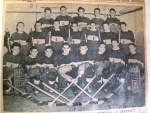 Équipe de hockey du C
Équipe de hockey du C
ollège (1940)
-
 Équipe de hockey du C
Équipe de hockey du C
ollège (1947) -
 Invitation pour céléb
Invitation pour céléb
rer la fête de ... -
 Invitation pour céléb
Invitation pour céléb
rer la fête de ... -
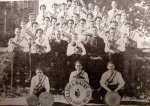 La fanfare du Collège
La fanfare du Collège
Sacré-Coeur de...
-
 La fanfare du Collège
La fanfare du Collège
Sacré-Coeur en... -
 La première rentrée,
La première rentrée,
en 1913 -
 Le Collège Sacré-Coeu
Le Collège Sacré-Coeu
r -
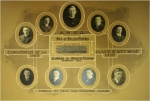 Les rhétoriciens, pro
Les rhétoriciens, pro
motion de 1928
-
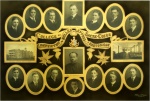 Les rhétoriciens, pro
Les rhétoriciens, pro
motion de 1934 -
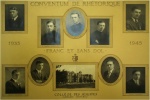 Les rhétoriciens, pro
Les rhétoriciens, pro
motion de 1945 -
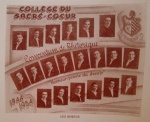 Les rhétoriciens, pro
Les rhétoriciens, pro
motion de 1954 -
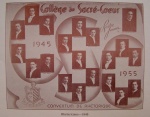 Les rhétoriciens, pro
Les rhétoriciens, pro
motion de 1955

